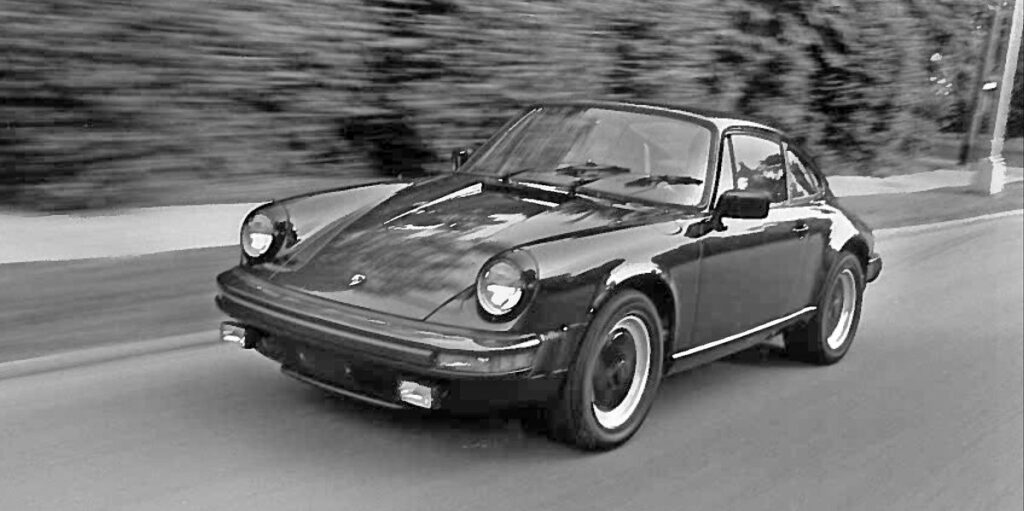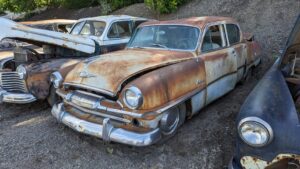1980 Porsche 911SC Tested: The Golden Oldie Hangs in There

From the August 1980 issue of Car and Driver.
We are born in one of two ways: to be drivers or to be passengers. Beyond the cosmic import of these two inclinations lie the facts of our lives, the ways we react to the highs and the lows of our lives. Presented with a slate-black Porsche 911SC, a reasonable assumption foresees in us an immediate upswing of good vibrations, some heavy breathing, and rising blips of the old heart rate. For drivers, these burgeoning sensations crackle in Vesuvian poppings of rapture. For passengers, it’s much worse.
Going along for the ride is less than a surefire way to live up to the passive side of one’s nature. Riding shotgun in a raging, spitting, hair-trigger 911SC is just about the most awful and impossible way there is to remain passive. This 911SC, this Thing, could draw screams from the pope. Confronted with streaming, onrushing impedimenta, even the most stolid passengers collapse into beyond-the-pale-of-reason seizures of fright. Their eyes pop, their knuckles get pasty, and they put teeth marks in their tongues. “This is like a roller coaster,” they whimper. “I hate roller coasters.” But the 911SC is addictive. If the driver knows how to wield this Tool of the Ultimate Whisk, the passenger comes around with an inspired turn of enthusiasm: “I want one, I want one!” It bursts forth uncontrollably.
There isn’t a soul alive who somehow doesn’t pooch out the boundaries of his or her personal performance envelope with insistent regularity. One way or another there are things to be tried, risks to be taken. Everybody likes to take the deep breath of commitment every so often. It begins with things as passive as cringing at Psycho and steps up to rush-hour jaywalking. Then, somewhere about in the middle, come roller coasters, the chance-taker’s delight. They don’t often derail or spit people out into the stratosphere, but they feel as if they were built for nothing else. Roller coaster graduates move straight on to full-contact karate, black belts shift over to everybody’s favorite game show, “Celebrity Decapitation,” and finally the survivor here gets to be Denis Jenkinson and rides with Stirling Moss at 180 mph for a thousand miles through darkest Italy.
Riding in a 911SC with someone who exhibits every intention of going really fast is sort of the ultimate, pumped-up pooching out of the more passive side of our nutty little envelopes. The only bad thing is that you can’t get on your knees; you’ve got to do your best prayers sitting down.
Andre LaRoche|Car and Driver
And now the question is, How much longer will Porsche be building these portable pews? Stuttgart has made noises before about the end being in sight for its hoary old coupe (and its ongoing Targa version), but even at today’s bloated price, it snags the old faithful and the new converts year after year. For good reason. If one can afford a 911SC, it is a helluva value. If not, it doesn’t make any difference. In the two years since we tested the first 911SC, its base price has jumped $10,000. But what you get for your $30,000 these days is probably the best rear-engined Porsche ever loaded on a boat. We mention this boat-loading-for-America business because cars for the European home market are blessed with better (read, lower and firmer and more precise) suspension settings, which make a tremendous difference in the way the cars feel and ultimately respond. Even so, the 1980 911SC is a happier compromise for the American market than the now discontinued 930 Turbo was.
The 911SC mixes strong performance with what we have reason to believe, based on history and typical German thoroughness and quality, should be outstanding reliability. This thing should run until your hair and teeth fall out and your family looks around for someplace to plant you.
The air-cooled flat-six whump-starts to a noisy idle, fast and healthy, busy with its performance preoccupation. A three-way catalyst and an oxygen sensor in the fuel injection take care of emissions without further add-ons. The resulting drivability and performance are second to none among mass-produced U.S.-available cars this year. This is an engine full of itself, cocky about what it can do. Send it your message and it hollers right back. Zero-to-60 takes 6.0 seconds flat, top speed is 130 mph, and overall mileage, even figuring in plenty of hard beating through the boondocks, runs out at 16 mpg.
For coming into corners we recommend close attention to the First Rule of Ongais, to wit: Get your braking done in a straight line, transition smoothly into the corner as you begin to feed throttle, bringing the car from basic understeer to a neutral distribution of cornering forces—i.e., all four wheels squared up. Just don’t indulge in a panicky rethink about slowing down by backing out of the gas. This over-your-head time is when you should dust off the First Rule of Bobby Allison, to wit: Floor it and steer like crazy.
We’ve always known that out behind the rear axle is no place for an engine to be, and Porsche has spent years trying to compensate. Currently—and ultimately?—Porsche has jacked up the car and grafted a number of hi-tech behavioral fixes into its outdated chassis. At this, Porsche has done better than ever before. The suspension calibrations, the wide rear wheels and tires, and the fat Pirelli P7 supertires all contribute to the reformation of the 911SC, but, as with a reformed drunk, the real shortcomings (semi-trailing-arm rear suspension and the clumsy rear weight bias thanks to the tail-hung engine) are still ready to crop up in moments of character weakness. But Porsche has done a masterly job of bringing the 911’s behavior into reasonable line.

Andre LaRoche|Car and Driver
The tech editor climbed into the SC and dragged the poor thing off for some skidpad abuse, and even he of the hypercritical persuasion came away impressed with Porsche’s progress. There is new and unexpected controllability at the raggedy edge. So we belted down to Ohio and molested its secret colloquial byways, ripping off as much as 600 miles a day in the depths of tightly enmeshed forests and hills.
At last light, we got out and ran a sensory check, and discovered all our faculties to be in good shape, and, except for a serious case of cop-eyes, no signs of personal wear and tear poked out any place. Much of the credit must go to the 911SC’s ventilated four-wheel disc brakes, which are a godsend. With the possible exceptions of the windshield and the steering wheel, there is nothing more useful on the car. The brakes produce overwhelming inversions of speed, transferring your insides about down to knee level under maximum braking. There’s next to no nose dive, and the pedal is ridiculously easy to modulate, oomphing the car down into corners as if a king-sized suction cup has been activated. The suspension absorbs whooping dips with no loss of equanimity, but jumping to daylight over lopsided crests gives those confounded semi-trailing arms too much of a chance to tweak the thing off kilter into a lopsided, darting landing. The steering is direct and quick, if fraught with kickback over bumps, and the five-speed gearbox is undoubtedly pleased with its latest linkage update, which still produces notchy shifts but with much more definite gates than in the past. Porsche never stops fiddling.
In the Porsche tradition, the instruments are thorough and splendidly arrayed. We wish this were true of the heating and ventilation controls, which are grouped in a panel unmarked except for defrost instructions.
One of the reasons the base price has leapt so drastically is a long list of formerly optional standards such as air conditioning, power windows, a center console, black outside trim, an engine-compartment light, and a leather-covered wheel. Our SC also has $2145 worth of fog lights, rear speakers, right-side electric mirror, sport shocks, forged alloy wheels, and the P7s. A Blaupunkt AM/FM/cassette unit with Dolby for hiss reduction channels its sound cleanly through four speakers, two of which are on the doors below long, handy storage bins neatly integrated into the armrests.
Our only problem with the 911SC, other than maintaining possession of the keys, was with the keys themselves. They are featherweight aluminum, and they bend easily, especially when ignition tumblers are slightly misaligned. Ours were. The key was bent a little, and one of them hung up in the start position instead of returning to the run position, which is supposed to disengage the starter. As a result, the starter toasted itself to a crisp and the ignition shorted out. We have Howard Cooper Volkswagen/Porsche+Audi in Ann Arbor to thank for a super-quick fix that allowed us to get the car into this issue.

Andre LaRoche|Car and Driver
The people-packaging core within the 911SC makes a halfhearted attempt at providing spots for two kids or two cramped adults in back (these seatlets fold down, providing useful luggage space over and above the five-cubic-foot trunk in the nose of the car). But the place where you live and work up front is first-cabin in every respect. Ours was superbly finished (except for a single drip of glue on the carpet) and tastefully colored. The soothingly shaped and padded seats were covered in fine, ventilated leather. Everything fits so snugly it seems to have been molded together almost to the point of meltdown.
Surrounding these fine appointments is one of the stoutest bodies ever, a clean design that incorporates the best-looking 5-mph bumpers on the market. Lacking the 930’s bulbous fenders and whale tail, the SC is less a caricature, more a subtle and righteous-looking notice of intent to commit unspecified illegalities, especially in fast corners.
Very fast corners. It is the roller coaster syndrome again. It is what the 911SC does. What is so pleasing about the whole proposition is that it also does so many other things so well. As compromises go, the 911SC is right at the top of the most intriguing heap of all, the one that peaks with works of man’s imagination that really aren’t compromises at all, because they’re capable of a near-infinite feat of the leaping-tall-buildings variety. Need a lift?
Counterpoint
For almost 30 years I’ve wanted to own whatever rear-engined Porsche has been in production at the time. I guess I’ve driven at least one example of every Porsche production car ever built, including a 1300 Super, and I’ve never been disappointed. Now, with this 911SC coupe, my boundless affection begins to wane. Certainly, the months and miles I’ve done in the Porsche 928 have done their bit to erode the love affair, but there’s more . . . This Porsche feels old, somehow. It feels as if it’s finally coming to the end of its allotted life space. I’m no longer willing to put up with the harshness, or the way the front end hunts and nibbles when you power it through a favorite country corner. I’m sure I would have liked it better without the Pirelli P7 tires, and I’m sure that I could still be tempted by a dark-gray Targa, but my 911 appetite isn’t as strong now. It didn’t help that the Audi 5000 Turbo passed through my hands simultaneously. Even with four doors and an automatic transmission, the Audi manages to do several things better than the Porsche. From now on, the Porsche of my dreams has a V-8 engine in the front. —David E. Davis, Jr.
The writing, it would seem, is on the wall. And what is written is that the venerable and venerated 911 is in the twilight of its years. I can remember when there were so many 911 variations I couldn’t keep them all straight. Now there’s just this one. Porsche says there will be a 911 as long as there is a demand for one, but it’s difficult to see the car or the demand lasting more than another couple of years. At the most. The 911SC is as good as it can be made. Porsche has massaged, refined, reworked, and improved on it until the car is as near perfection as it can be. And that’s why it will go away. Innovation and challenge are very important to Porsche. The 911 no longer provides either. It has outlived its usefulness, and as attrition takes the die-hard traditionalists, the 911 will finally outlive its demand. I loved driving the SC, and I could live a long and happy life with it. It’s still that good, that satisfying. But we’re getting a 928 in a few weeks, and I know it will turn my head, and it’ll make my knees feel funny, and the hair stand up on the back of my neck. The 911 just doesn’t do that to me anymore. The 928 is the now Porsche, and that’s fine by me. —Mike Knepper
Porsche hereby inherits enviable distinction as the most accelerative car money can buy in these United States. With no help from a turbocharger. There are those that peak out a bit higher, but the Stuttgart Super Beetle gets you there quicker. This demands a certain amount of respect even from those who—like me—decry the obsolescence of rear-engine layouts. You’ve also go to credit Porsche for the 911’s staying power. It holds the record as the oldest car design still in production for America (not counting the Avanti and the Checker). One thing that has changed over the years is the 911’s penchant for oversteer. I find it at an all-time low in this 1980 model with the Sport group. It stuck and stuck on our skidpad, finally drifting over the limit front first. Lifting abruptly off the throttle hardly made it twitch. So the P7s and wider rear wheels are a must. I was also happy with the real-world handling, but I wouldn’t touch the sport shocks with a stick. Over broken pavement and Michigan-class expansion strips (the one-inch-high kind), the so-called dampers fitted to our tester went rigid. Two hours on a bad highway gave me a headache. Now I know what they were thinking of when the 911’s soft-ride package came out a few years back. —Don Sherman
Arrow pointing downArrow pointing down
Specifications
Specifications
1980 Porsche 911SC
Vehicle Type: rear-engine, rear-wheel-drive, 2+2-passenger, 2-door coupe
PRICE
Base/As Tested: $27,700/$30,470
Options: F25 option group, $2145; metallic paint, $625.
ENGINE
SOHC flat-6, aluminum block and heads, direct fuel injection
Displacement: 183 in3, 2990 cm3
Power: 172 hp @ 5500 rpm
Torque: 189 lb-ft @ 4200 rpm
TRANSMISSION[S]
5-speed manual
CHASSIS
Suspension, F/R: struts/control arms
Brakes, F/R: 9.0-in vented disc/9.6-in vented disc
Tires: Pirelli Cintuato P7
F: 205/55VR-16
R: 225/50VR-16
DIMENSIONS
Wheelbase: 89.4 in
Length: 168.9 in
Width: 65.0 in
Height: 52.0 in
Passenger Volume, F: 46 ft3
Trunk Volume: 5 ft3
Curb Weight: 2700 lb
C/D TEST RESULTS
60 mph: 6.0 sec
1/4-Mile: 14.7 sec @ 92 mph
100 mph: 18.4 sec
Top Speed: 130 mph
Braking, 70–0 mph: 169 ft
Roadholding, 218-ft Skidpad: 0.80 g
EPA FUEL ECONOMY
Combined (est.): 16 mpg
C/D TESTING EXPLAINED




